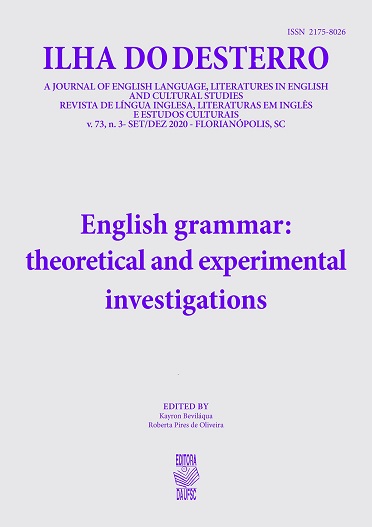Avaliação do desenvolvimento da proficiência oral no segundo idioma com escalas holísticas e analíticas
DOI:
https://doi.org/10.5007/2175-8026.2020v73n3p227Resumo
O presente estudo discute como um grupo de avaliadores experientes usa diferentes tipos de escalas para avaliar o desenvolvimento da proficiência oral em inglês como segunda língua (L2). Os avaliadores atribuíram taxas a amostras de fala primeiro usando uma escala holística (CEFR, 2018) e depois atribuindo taxas de pronúncia, vocabulário, gramática e desempenho de fluência usando escalas individuais. As amostras de fala foram gravadas por cinco brasileiros. Houve duas sessões de coleta de dados, com a segunda ocorrendo 7-8 meses após a primeira. Os resultados indicam altos níveis de concordância entre avaliadores para todas as escalas. Além disso, os avaliadores detectaram mudanças no desempenho dos falantes em quatro das cinco escalas: proficiência oral L2, vocabulário, gramática e fluência, e essas diferenças nas taxas ao longo do tempo foram significativas para proficiência oral, vocabulário e fluência. Assim, os diferentes tipos de escala permitem detectar o desenvolvimento da proficiência oral de L2.
Referências
BENT, T., BRADLOW, A. The interlanguage speech intelligibility benefit. The Journal of the Acoustical Society of America, v. 114, n. 3, p. 1600-1610, 2003.
CEFR: Common European Framework of Reference for Languages: Learning, Teaching, Assessment, 2001. http://www.coe.int/t/dg4/linguistic/source/framework_en.pdf
De JONG, N. H., GROENHOUT, R. S., SCHOOEN, R., HULSTIJN, J H. Second language fluency: speaking style or proficiency? Correcting measures of second language fluency for first language behavior. Applied Psycholinguistics, v. 36, n. 2, p. 223–43, 2015.
DERWING, T. M.; MUNRO, M. J.; THOMSON, R. I. A Longitudinal Study of ESL Learners’ Fluency and Comprehensibility Development. Applied Linguistics, v. 29(3), p. 359–380, 2007.
DERWING, T., MUNRO, M. Accent, comprehensibility and intelligibility: Evidence from four L1s. Studies in Second Language Acquisition, v. 19, p. 1-16, 1997.
DERWING, T.; MUNRO, M. Pronunciation Fundamentals: Evidence-Based Perspectives for L2 Teaching and Research. Language Teaching Series, n. 42, 2015.
FERRARI, S. A longitudinal study of complexity, accuracy and fluency variation in second language development. In: HOUSEN, A.; KUIKEN, F.; VEDDER, I. Dimension of L2 Performance and Proficiency: Complexity, Accuracy and Fluency in SLA. Amsterdam/Philadelphia: John Benjamins, 2012. p. 277-298.
GASS, S., VARONIS, E. The effect of familiarity on the comprehensibility of nonnative speech. Language Learning, v. 34, n. 1, p. 65–89, 1984.
HAYES-HARB, R., HACKING, J. Beyond rating data: What do listeners believe underlies their accentedness judgments? John Benjamins Publishing Company, v. 1(1), p. 43-64, 2015.
HUANG, B. H., & JUN, S. A. Age matters, and so may raters: Rater differences in the assessment of foreign accents. Studies in Second Language Acquisition, vol. 37, no. 4, p. 623–650, 2015.
HULSTIJN, J. H. The construct of language proficiency in the study of bilingualism from a cognitive perspective. Bilingualism: Language and Cognition, v. 15(2), p. 422 – 433, 2012.
NEIDE, C. Familiaridade do ouvinte e inteligibilidade da pronúncia de aprendizes brasileiros de inglês. Revista Horizontes de Linguística Aplicada, v. 7, n. 1, p. 88-103, 2008.
NIVJA H. DE JONG; RACHEL GROENHOUT; ROB SCHOONEN. Second language fluency: Speaking style or proficiency? Correcting measures of second language fluency for first language behavior. Applied Psycholinguistics, v. 36(2), p. 223-243, 2015.
O’BRIEN, M. Methodological choices in rating speech samples. Studies in Second Language Acquisition, v. 38(3), p. 587-605, 2016.
ORTEGA, L., HAN, Z.(Ed.): Complexity Theory And Language Development: In Celebration Of Diane Larsen-freeman. John Benjamins, 2017.
SAITO, K., SUZUKIDA; Y., SUN, H. Aptitude, experience, and second language pronunciation proficiency development in classroom settings: A longitudinal study. Studies in Second Language Acquisition, p. 1-25, (to appear in 2019).
SAITO, K.; HANZAWA, K. Developing second language oral ability in foreign language classrooms: The role of the length and focus of instruction and individual differences. Applied Psycholinguistics, v. 37, p. 813–840, 2016.
SHINTANI, N., SAITO, K., KOIZUMI, R. The relationship between multilingual raters' language background and their perceptions of accentedness and comprehensibility of second language speech. International Journal of Bilingual Education and Bilingualism, p. 849-869, 2017.
XXXXXXX (2018)
XXXXXXX (2011)
XXXXXXX (2012)
Downloads
Publicado
Edição
Seção
Licença
Copyright (c) 2020 Rosane Silveira

Este trabalho está licenciado sob uma licença Creative Commons Attribution 4.0 International License.
A revista Ilha do Desterro publica artigos e resenhas inéditos, referentes as áreas de Inglês, Literaturas em Língua Inglesa e Estudos Culturais. Publica volumes mistos e/ou temáticos, com artigos e resenhas em inglês e português.
Autores mantém os direitos autorais e concedem à revista o direito de primeira publicação, com o trabalho simultaneamente licenciado sob a Licença Creative Commons Attribution que permite o compartilhamento do trabalho com reconhecimento da autoria e publicação inicial nesta revista.

This work is licensed under a Creative Commons Attribution 4.0 International License.



